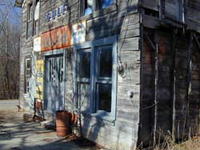 Back to the Sutherland page
Back to the Sutherland page
 This is the Old Saddle Store in Saddle AR
This is the Old Saddle Store in Saddle AR
Old Store is Saddle landmark
SADDLE STORE The former Saddle Store at Saddle on Arkansas 289 was recently added to the National Register of Historic Places.
The old store continues to be a landmark in the small Fulton County community.
SADDLE -- Travelers driving through Saddle on Arkansas 289 can't miss the old dam and the former Saddle Store.
While viewing the landmarks, they might get a sense of what the small eastern Fulton County community was like in its beginning in the late 1800s or in its heyday in the 1920s.
Located on the idyllic South Fork River, Saddle may be a faded memory for many, but Zara Sutherland Jones, who lived there in the 1920s, recalls the town as if it were yesterday.
The features of Saddle were its grist and flour mills and cotton gin, said Doug Jones of Fulton County, who added that the dam was built in 1870 with rocks from a nearby bluff.
"That's what Saddle was all about," Jones said.
At that time, he said, Saddle was referred to as Sharp's Mill, after its founder, Ephraim Sharp. The town was later called South Fork because that was the name the local post office adopted.
However, it is the Saddle Store that stirs the memories of Mrs. Jones and also has captured the attention of the Arkansas Historic Preservation Program.
The Saddle Store, about a half mile from the dam, was listed on the National Register of Historic Places on Nov. 15, said Mark Christ of the AHPP.
The store is a gable-roofed, plain-traditional building set on a hill on the eastern side of Arkansas 289. Now abandoned, the building is relatively intact and has never had additions.
Although it is believed that the building was constructed in 1916, Mrs. Jones, who moved to the area in 1921, claims the Saddle Store was built in 1927. The AHPP indicated that "either Joe Hatman or a Mr. (Jim) Benton constructed the store."
"Joe Hatman (who was a Saddle merchant) is the one who had it built," Mrs. Jones said.
She recalled that Hatman operated a creamery underneath the general mercantile.
Mrs. Jones said that Hatman, who had moved to Saddle from Hardy, operated Molly Nickels' general store, which was located closer to the dam, before having the existing Saddle Store built. Mrs. Jones indicated that Mrs. Nickels became ill, moved to town and sold her store to Mrs. Jones' father, De Witt "D.W." Sutherland.
Mrs. Jones also recalled how the new name of the town of Saddle came about. She said Bill Riley had a shop behind the Saddle Store where he shod horses and that Earl Sterling was in charge of the post office.
At about the time the men were deciding on a name for the town while standing on the porch of the Saddle Store, she said Hershel Rogers brought his son's saddle around the side of the building. Upon noticing the saddle, one of the men recommended calling the town Saddle, and it stuck, said Mrs. Jones.
The South Fork Post Office was discontinued on May 29, 1925, and the Saddle Post Office was built March 20, 1928, said Jones.
"Earl Langston was the postmaster at South Fork. He had the post office in Jim Benton's store. He got sick and left. It (the post office) went dead for three years," said Mrs. Jones.
Mrs. Jones also recalled attending school across the highway from the Saddle Store, where a forest is now located, and swimming in a nearby creek.
The Saddle School, which Mrs. Jones attended, was built in 1928, she added. She possesses a school roster that lists her name, her birthdate as Sept. 24, 1913, and her age as 14. She was in a class of about 40 students ranging in ages from 6 to 19. She recalled playing baseball and basketball at the school, walking to Shiloh, Agnos and Heart in the evenings and seeing 100 teams and wagons at once in the old town of Saddle.
Although Saddle did not get a church until 1951, according to Mrs. Jones, a preacher would visit and preach at the school occasionally.
Mrs. Jones also said a third general store, besides the Saddle Store and Mary Nickels' store, was located nearby at one time.
The existing Saddle Store setting includes a gable-roofed outbuilding with attached privy, a retaining wall and an unearthed gasoline tank.
The signage on the building proclaims "GULF," "Saddle Store," and includes advertisements for Pepsi and Gold Crown Stamps. Jones said the store, which is now owned by Jamie Tompkins and his father, Herman O. "Tom" Tompkins, closed in the 1980s. It closed because it couldn't compete with larger grocery stores, he added.
The building has a rectangular, two-story floor plan, resting on a raised continuous concrete foundation with a partial basement, according to information provided by the AHPP. The store is sided by flush horizontal board. The original window openings remain. However, the windows themselves are deteriorated or missing on some elevations.
The moderately pitched gable roof is covered by metal roofing material, and an interior metal flue pipe pierces the roof near the southeastern corner of the building.
On the building's front (south) side, a pair of one-over-one windows flanks the double-door front entryway. Access is obtained to the doors via concrete stairs set into the cast concrete porch. Above, the second story contains two matching pairs of windows.
"The deterioration of the building does not detract from the building's integrity of workmanship or feeling of history," according to the AHPP.
The building has had many owners, including the Hatmans, Verny and Mildred Howard, Victoria and Charles Belknap and the Tompkins family.
"The Saddle Store remained in continuous business from 1917 until 1988 as a general store," according to AHPP.
The AHPP report also indicated that the present owner wants to stabilize and restore the building.
The structure was nominated to the National Register of Historic Places under the criterion of its stately plain-traditional design. Because of the gas station and the position of the building on Arkansas 289, the building is significant for its association with automobile transportation in Arkansas. Thus, it was nominated under the historic context -- "Arkansas Highway History and Architecture, 1910-1965."
According to the AHPP, gasoline products were available through Walker Gulf Oil and Bates Oil Co. in Mammoth Spring.
The pump was hand powered, with a glass measuring bowl. It was later replaced by a modern pump.
Besides being a general store and a gas station, the facility was used throughout the years as a voting place and a community building.
By SHERRY PRUITT
Copyright 1999, Jonesboro Sun.
Jonesboro Arkansas
Created and supported by Internet Solutions, Inc.
Thanks for stopping by..
